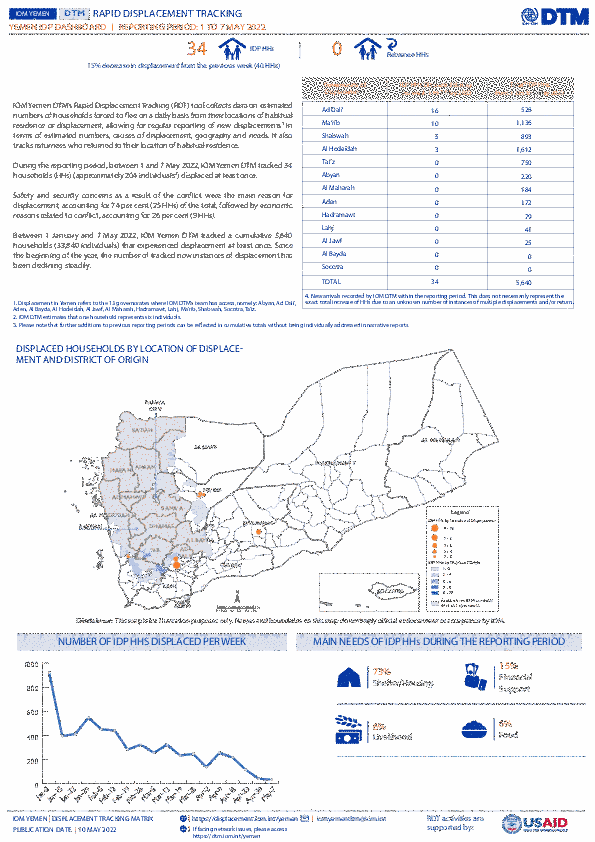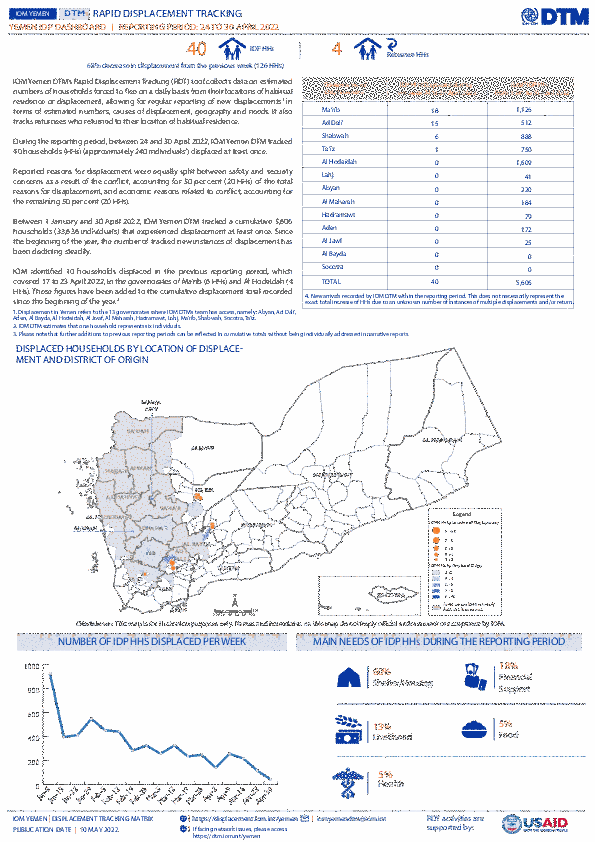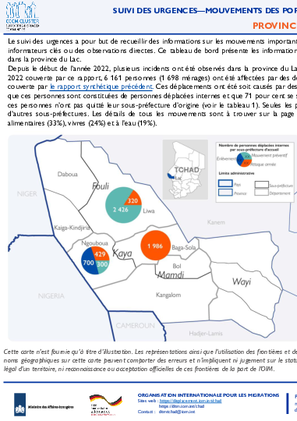-
Countries
-
Data and Analysis
-
Special Focus
-
Crisis Responses

Contact
DTM Turkey, dtmturkey@iom.int
Language
English
Location
Republic of Türkiye
Period Covered
Apr 01 2022
Apr 30 2022
Activity
- Flow Monitoring
- Migrants presence
- Mobility Tracking
According to the latest available figures from the Turkish Presidency of Migration Management (PMM), there are more than 5.2* million foreign nationals present in Turkish territory, 3.7* million of whom are seeking international protection. Most are Syrians (3,762,686* individuals) who are granted temporary protection status. In addition, international protection applicants from countries including Afghanistan, the Islamic Republic of Iran and Iraq constitute another group of foreign nationals. According to
PMM, there were 29,256* international protection applicants present in Turkey in 20211, published annually. Moreover, according to UNHCR**, there are close to 330,000 international protection status holders and asylum-seekers. The number of foreign nationals has increased by 90,266 in comparison to April 2021 (3.7 million foreign nationals).
In addition, there are 1,417,997* foreign nationals present in Turkey holding residency permits, including humanitarian residency holders. Compared to April 2021, this is an increase of 318,714 individuals. The exact number of humanitarian residency holders is unknown, but it is estimated that there are more than several thousand humanitarian residency permit holders.
*Data source PMM, 28.04.2022
**Data source UNHCR, December 2021
Contact
DTM Yemen, iomyemendtm@iom.int
Location
Yemen
Activity
- Mobility Tracking
- Event Tracking
Period Covered
May 01 2022 -May 07 2022
IOM Yemen DTM’s Rapid Displacement Tracking (RDT) tool collects data on estimated numbers of households forced to flee on a daily basis from their locations of origin or displacement, allowing for regular reporting of new displacements in terms of estimated numbers, geography, and needs. It also tracks returnees who returned to their location of origin.
From 1 January to 7 May 2022, IOM Yemen DTM tracked 5,640 households (HH) (33,840 Individuals) who experienced displacement at least once.
Between 1 and 7 May 2022, IOM Yemen DTM tracked 34 households (204 individuals) displaced at least once. The majority of people moved into/within the following governorates and districts:
Between 1 and 7 May 2022, IOM Yemen DTM tracked 34 households (204 individuals) displaced at least once. The majority of people moved into/within the following governorates and districts:
- Ad Dali (16 HHs) – Ad Dali (11 HHs), Qatabah (5 HHs) districts. Most displacements in the governorate originated from Taiz and Ad Dali.
- Marib (10 HHs) – Marib City (9 HHs), Marib (1 HHs) districts. Most displacements in the governorate originated from Marib and Taiz.
- Shabwah (5 HHs) – Ataq (5 HHs) district. Most displacements in the governorate originated from Ibb and Taiz.
- Taiz (12 HHs) – Mawiyah (6 HHs), Maqbanah (3 HHs), Al Maafer (2 HHs) districts.
- Ad Dali (6 HHs) – Qatabah (4 HHs), Al Husha (2 HHs) districts.
- Ibb (5 HHs) – Al Odayn (5 HHs) district.
Population Groups
Survey Methodology
Unit of Analysis Or Observation
Type of Survey or Assessment
Keywords
Geographical Scope
Administrative boundaries with available data
The current dataset covers the following administrative boundaries
Contact
DTM Yemen, iomyemendtm@iom.int
Location
Yemen
Activity
- Mobility Tracking
- Event Tracking
Period Covered
Apr 24 2022 -Apr 30 2022
From 1 January to 30 April 2022, IOM Yemen DTM tracked 5,606 households (HH) (33,636 Individuals) who experienced displacement at least once.
Between 24 and 30 April 2022, IOM Yemen DTM tracked 40 households (240 individuals) displaced at least once. The majority of people moved into/within the following governorates and districts:
Between 24 and 30 April 2022, IOM Yemen DTM tracked 40 households (240 individuals) displaced at least once. The majority of people moved into/within the following governorates and districts:
- Marib (18 HHs) – Marib City (14 HHs), Marib (4 HHs) districts. Most displacements in the governorate originated from Ibb and Marib.
- Ad Dali (15 HHs) – Ad Dali (9 HHs), Qatabah (6 HHs) districts. Most displacements in the governorate originated from Taiz and Ad Dali.
- Shabwah (6 HHs) – Bayhan (6 HHs) district. Most displacements in the governorate originated from Al Bayda.
- Ibb (12 HHs) – Hobeish (3 HHs), Al Odayn (2 HHs), Al Qafr (2 HHs) districts.
- Taiz (6 HHs) – Al Qahirah (2 HHs), Mawiyah (2 HHs), Sami (1 HHs) districts.
- Al Bayda (6 HHs) – Nati (5 HHs), Radman (1 HHs) districts.
Population Groups
Survey Methodology
Unit of Analysis Or Observation
Type of Survey or Assessment
Keywords
Geographical Scope
Administrative boundaries with available data
The current dataset covers the following administrative boundaries

Contact
DTM Yemen, iomyemendtm@iom.int
Language
English
Location
Yemen
Period Covered
May 01 2022
May 07 2022
Activity
- Rapid Emergency Registration
- Mobility Tracking
IOM Yemen DTM’s Rapid Displacement Tracking (RDT) tool collects data on estimated numbers of households forced to flee on a daily basis from their locations of origin or displacement, allowing for regular reporting of new displacements in terms of estimated numbers, geography, and needs. It also tracks returnees who returned to their location of origin.
From 1 January to 7 May 2022, IOM Yemen DTM tracked 5,640 households (HH) (33,840 Individuals) who experienced displacement at least once.
Between 1 and 7 May 2022, IOM Yemen DTM tracked 34 households (204 individuals) displaced at least once. The majority of people moved into/within the following governorates and districts:
- Ad Dali (16 HHs) – Ad Dali (11 HHs), Qatabah (5 HHs) districts. Most displacements in the governorate originated from Taiz and Ad Dali.
- Marib (10 HHs) – Marib City (9 HHs), Marib (1 HHs) districts. Most displacements in the governorate originated from Marib and Taiz.
- Shabwah (5 HHs) – Ataq (5 HHs) district. Most displacements in the governorate originated from Ibb and Taiz.
The majority of people moved from the following governorates and districts:
- Taiz (12 HHs) – Mawiyah (6 HHs), Maqbanah (3 HHs), Al Maafer (2 HHs) districts.
- Ad Dali (6 HHs) – Qatabah (4 HHs), Al Husha (2 HHs) districts.
- Ibb (5 HHs) – Al Odayn (5 HHs) district.

Contact
DTM Yemen, iomyemendtm@iom.int
Language
English
Location
Yemen
Period Covered
Apr 24 2022
May 10 2022
Activity
- Rapid Emergency Registration
- Mobility Tracking
IOM Yemen DTM’s Rapid Displacement Tracking (RDT) tool collects data on estimated numbers of households forced to flee on a daily basis from their locations of origin or displacement, allowing for regular reporting of new displacements in terms of estimated numbers, geography, and needs. It also tracks returnees who returned to their location of origin.
From 1 January to 30 April 2022, IOM Yemen DTM tracked 5,606 households (HH) (33,636 Individuals) who experienced displacement at least once.
Between 24 and 30 April 2022, IOM Yemen DTM tracked 40 households (240 individuals) displaced at least once. The majority of people moved into/within the following governorates and districts:
- Marib (18 HHs) – Marib City (14 HHs), Marib (4 HHs) districts. Most displacements in the governorate originated from Ibb and Marib.
- Ad Dali (15 HHs) – Ad Dali (9 HHs), Qatabah (6 HHs) districts. Most displacements in the governorate originated from Taiz and Ad Dali.
- Shabwah (6 HHs) – Bayhan (6 HHs) district. Most displacements in the governorate originated from Al Bayda.
The majority of people moved from the following governorates and districts:
- Ibb (12 HHs) – Hobeish (3 HHs), Al Odayn (2 HHs), Al Qafr (2 HHs) districts.
- Taiz (6 HHs) – Al Qahirah (2 HHs), Mawiyah (2 HHs), Sami (1 HHs) districts.
- Al Bayda (6 HHs) – Nati (5 HHs), Radman (1 HHs) districts.

Contact
DTMMozambique@iom.int
Language
English
Location
Mozambique
Period Covered
Apr 27 2022
May 03 2022
Activity
- Mobility Tracking
- Event Tracking
During the reporting period (27 April to 03 May 2022), a total of 18 movements were recorded - 7 returns (1,276 individuals), 10 arrivals (311 individuals), and 1 departure (32 individuals). The largest return movements were recorded in Muidumbe (1,118 individuals) and Palma (158 individuals). The largest arrival movements were recorded in Nangade (239 individuals), and Ancuabe (67 individuals). The departure was observed in Metuge (32 individuals). Of the total population, 10 per cent of mobile groups were displaced for the first time, and 90 per cent of reported individuals have been displaced more than once prior to this movement.
This document presents an analysis of interviews conducted with all individuals assisted in their voluntary return by the International Organization for Migration (IOM) between 2017 and 2021 (130,424) to one of the 23 countries covered by the West and Central Africa region (WCA). The analysis combines datasets from both Assisted Voluntary Return and Reintegration (AVRR) and Voluntary Humanitarian returns (VHR).

Contact
DTMMozambique@iom.int
Language
English
Location
Mozambique
Period Covered
Apr 01 2022
Apr 30 2022
Activity
- Mobility Tracking
- Event Tracking
During the reporting period (1st to 30 April 2022), a total of 53 movements were recorded - 17 arrivals (175 individuals). 31 departures (526 individuals) and 5 returns (426 individuals). The largest individuals arrival movements (137 individuals) and departure movements (225 individuals) were recorded in Cidade de Nampula. Of the total population, 42 per cent of mobile groups were displaced for the first time, and 52 per cent of reported individuals have been displaced more than once prior to this movement.

Contact
DTM Tchad, dtmtchad@iom.int
Language
French
Location
Chad
Period Covered
Apr 24 2022
Mar 27 2022
Activity
- Mobility Tracking
- Event Tracking
Depuis le début de l’année 2022, plusieurs incidents ont été observés dans la province du Lac occasionnant un grand nombre de déplacements. Durant la période du 24 février au 27 mars 2022 couverte par ce rapport, 6 161 personnes (1 698 ménages) ont été affectées par des déplacements, soit 56 pour cent de moins comparé à la période du 10 janvier au 21 février 2022 couverte par le rapport synthétique précédent. Ces déplacements ont été soit causés par des attaques armées (45%), soit préventifs par peur (44%) ou des enlèvements (11%). Il est à noter que ces personnes sont constituées de personnes déplacées internes et que 71 pour cent se sont déplacées à l'intérieur de leurs sous-préfectures. Cela signifie que lors de leur déplacement, ces personnes n’ont pas quitté leur sous-préfecture d’origine (voir le tableau 1). Seules les personnes sujettes à des incidents dans la sous-préfecture de Ngouboua se sont réfugiées dans d’autres sous-préfectures. Les détails de tous les mouvements sont à trouver sur la page 2. Les besoins prioritaires de ces personnes déplacées comprennent l'accès aux articles non alimentaires (33%), vivres (24%) et à l’eau (19%).

Contact
DTM DRC, iomdrcdtm@iom.int
Language
French
Location
Democratic Republic of the Congo
Period Covered
Mar 15 2022
Mar 23 2022
Activity
- Registration
- Mobility Tracking
- Site Assessment
- Baseline Assessment
Cette fiche d’information présente les éléments clés tirés des résultats consolidés des opérations d’enregistrement menées par l’OIM dans les trois (3) sites de déplacement dont les sites de KATANA et RUGO dans le territoire de Kalemie le 15 mars 2022 et le site de MWEMPA dans le territoire de Nyunzu le 23 mars 2022. Des équipes d’enquêteurs se sont rendues dans ces sites de déplacement afin de vérifier hutte par hutte la présence des ménages déplacés. Dans chaque hutte habitée, les enquêteurs ont procédé à l’enregistrement des ménages présents. Ce travail a été fait sur le terrain en collaboration avec les comités des déplacés et la Division des Affaires Humanitaires (DIVAH) au Tanganyika.

